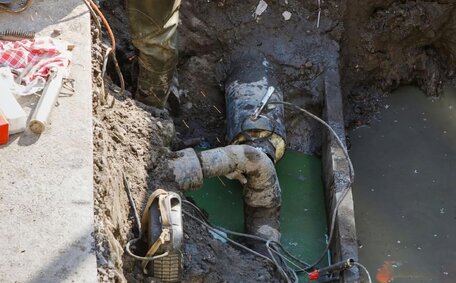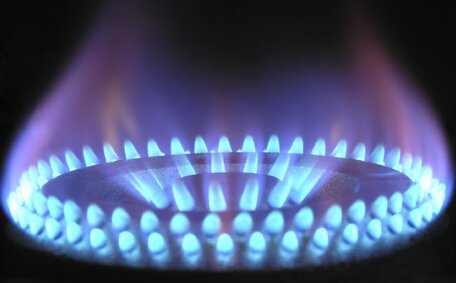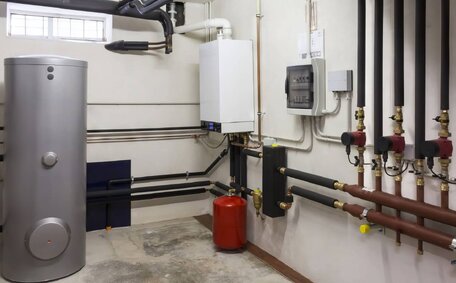
Sump Pump Failure Solutions
Sump pumps fail due to power outages, clogs, frozen pipes, and more. Prevent water damage by understanding causes and contacting plumbers for solutions to extend pump life.
Read MoreSelecting the proper installation location for your hot water system is essential for efficiency, safety, and ease of maintenance. The optimal location varies depending on the type of system, your home’s layout, and water usage habits.
For basic electric hot water system options or gas hot water system choices, the system can be positioned close to the most frequently used hot cold water taps to minimise heat loss over long pipe runs.
Ensure easy access for maintenance and verify the floor can bear the weight of a full tank. Locate away from air conditioners which could corrode the exterior over time.
Outdoor water systems must have optimal sun exposure and ventilation for heat pump efficiency. Ensure collectors are set at the ideal angle, preferably facing north, and positioned on concrete pads with weather protection.
Factor in the proximity to water supply routes, power sources, and consider potential noise disturbances. Specialised plumbing and electrical work is required for systems connected to solar PV. Consult our professional plumbers for efficient, secure installation and customised advice.
The choice of location for new indoor water storage tanks depends on various factors. Accessibility is crucial - provide clear space around the unit for maintenance and leave room to safely drain water during servicing. Place the unit away from high-traffic areas while maintaining easy access.
Consider child safety too. Install protective barriers if children are in the household.
Structural integrity is vital. Avoid upper levels or attics with inadequate load capacity.
If necessary, reinforce the floor to support the tank, which can weigh up to 600kg when filled. Install a drip tray under electric hot water systems to catch leaks and prevent damage or faults.
Position your water system near fixtures with high hot water demand for best efficiency. Minimise potential heat loss over long pipe runs. However, also consider existing plumbing layouts when identifying suitable areas.
Ensure newly installed indoor tanks have proper airflow clearance around them, as per manufacturer guidelines.
Proper alignment of solar hot water collectors is essential for peak efficiency. Face panels northwards and tilt at an angle of 22 to 40 degrees in Cronulla to maximise sun exposure for optimally heated water. This alignment provides the greatest energy yield for systems that heat water efficiently.
Mount collectors on roof spaces where your water heater can operate optimally and, where necessary, we can install without overshadowing from surrounding trees or structures. Nearby shading causes significant solar capture losses. If roof mounting isn’t possible, install free-standing ground collectors on concrete pads - but ensure accessibility for maintenance.
Consider the location of existing hot water pipes when siting panels. Minimal pipe runs are preferable to minimise potential heat losses. Also confirm the roof’s structural integrity for additional weight loadings if required.
Outdoor system installation captures direct solar benefits, enhancing solar efficiency. Homeowners should be aware that indoor mounting reduces efficiency unless light-transferring solar tubes are used. Speak to our team if you have any questions about correctly positioning solar hot water systems.
Before installation, verify local regulations regarding noise levels for heat pump units. Noise control laws should be regarded similarly to those for air conditioners - units mustn’t exceed allowable decibel levels.
To minimise disruption, we recommend positioning installing heat pump water heaters away from bedrooms and living areas. Install heat pumps on concrete pads with dampeners and secure solar collectors to minimise noise transmission. Insulate pipework connected to outdoor units too.
Also take care when placing units near property boundaries. We can assist in maintaining a 3-metre clearance from fences, and a 4-metre gap from neighbouring buildings. This prevents noise intrusion for neighbours.
Our expert team, whom you can hire professional plumbers from, can verify that the system your home utilises complies thoroughly with pertinent regulations. We’ll ensure your new hot water replacement complies with all necessary standards, contact us to discuss your upcoming installation.
When setting up a new water heating system, adhering to all the relevant safety standards and plumbing codes is essential. This ensures the system operates safely and efficiently.
Gas storage or instantaneous units must have appropriate exhaust flues for external by-product removal. Gas storage or instantaneous units must have appropriate exhaust flues for external by-product removal.
We ensure flues are properly distanced from home entries and handle compliant exhaust routing.
We’ll also install a tempering valve and take care of all necessary compliance paperwork for council sign off after completing your installation. This guarantees you meet local hot water regulations.
Other key safety steps include installing a pressure relief valve and pressure controls to storage tanks for your peace of mind.
Meeting regulations and codes during installation ensures your system operates safely for years to come. Our team handles the entire process seamlessly from start to finish, enhancing the life your installation. Contact us to arrange your next water services installation.
Selecting the right hot water unit and capacity is important for meeting your household’s requirements efficiently. Consider factors like:
A general guideline is to allot approximately 50 litres of storage capacity per person for electric hot water tanks. For continuous flow systems like instantaneous gas, determine the appropriate system size according to litres per minute of peak demand.
our team can assess your home’s specific requirements, giving attention to your unit, property size constraints, and budget. We’ll recommend the most suitable system type and capacity for your house. This ensures optimal efficiency and performance for years to come while keeping installation and operating costs reasonable.
Upsizing your water units may cost more upfront but can pay off through greater energy savings down the track. Contact us to size and select the right system for your home’s needs.
When selecting an energy source for your new hot water system, key aspects to compare include:
Electric systems have the highest running costs, while solar collectors and heat pumps are the more efficient energy options. Gas systems fall somewhere in the middle. Carefully weigh upfront purchase price of a type hot water system vs long term savings on utilities.
For reduced emissions, solar heat pump solutions and solar collectors teamed with electric boosters are among the greenest options. However, gas systems still produce fewer emissions than electric only.
Solar requires adequate sunlight, while heat pumps depend on air temperatures.
Factor in your usage patterns and needs, with gas systems providing consistent hot water on demand.
It’s pivotal to ensure that your water heater inside enjoys open ventilation and ready access, characteristic of outdoor heat pumps and solar setups. Indoor electric hot water heater tanks, when installed inside, should be considered with care regarding the space in your home. Measure available room when deciding between system types.
Our team can provide tailored advice comparing the available energy sources based on your household, budget and preferences. Contact us to discuss selecting the right system for your circumstances.
Installing water heaters often involves overcoming challenges like limited space, difficult access or compliance hurdles. Carefully survey conditions beforehand to identify potential obstacles.
For your hot water heater inside, confirm floor load capacity, measure doorway clearance and ensure adequate room for servicing access. Outdoors, inspect pad foundations and roof integrity for collectors. Also check sunlight exposure, ventilation and noise constraints relative to boundaries.
Youll need to factor in complex proprietary plumbing between existing systems that may pose challenges during installations. Additionally, permits, electrical upgrades or exhaust fluing issues could arise. We guarantee your system is compliant with current regulations.
By assessing all plumbing needs in advance, we foresee and tackle installation issues that may occur with your new system. Our extensive experience ensures you’ll need not worry, as we efficiently troubleshoot any problems if needed. We manage all plumbing and electrical aspects efficiently from initiation to completion.
Proper maintenance is crucial for extending the lifespan of your unit can actually extend to 15 years or longer. This prevents expensive breakdowns of your old system and ensures energy efficient operation.
Schedule annual services to check and adjust elements and anodes in your water tank. Top up expansion control valves on mains pressure systems too. For hot water heaters with solar collectors, clean glass panes and confirm tilt angles twice yearly, while checking heat pump air filters and fans annually.
Also make sure to monitor for changes suiting your needs, like avoiding leaks, maintaining consistent water temperatures, and ensuring proper pressure and flow. Seek prompt assistance if the water becomes too hot or other issues develop between services. Additionally, flush heat exchangers and full systems every 5 years to prevent sediment buildups.
Accessibility greatly aids maintenance - we recommend allowing at least 30cm clearance around indoor units. Outdoors, position tanks, collectors and heat pumps on concrete pads with roof access for drainage and repairs. And installing isolation valves simplifies isolating parts during servicing.
Regular service schedules and prompt issue resolution maintain system efficiency over time. Your plumber and our experienced technicians handle all specialist maintenance tasks.
Installing a new hot water system in Cronulla can become more cost-effective with available government rebates. Rebates aim to incentivise households to upgrade to more sustainable and eco-friendly systems.
Cronulla homeowners can claim variable hot water rebate incentives from the NSW government for heat pump or solar installations. Hot water rebates can reduce your upfront purchase and installation costs by hundreds or even thousands of dollars.
To receive the full rebate amount your household income must fall under set thresholds. We can assess your eligibility and handle all paperwork to secure your entitled water rebate amount.
Hot water rebates vary between heat pump water system types. Current solar hot water system rebates in Cronulla provide up to $500 back. Even more generous incentives up to $3,000 are available for a new hot water heater with heat pump technology.
Our team is ready to tackle common hot water system installations and remains fully abreast of the latest government rebate schemes. We can help ensure you receive all entitled payments when installing eco-friendly hot water systems, delivering maximum savings.
Sump pumps fail due to power outages, clogs, frozen pipes, and more. Prevent water damage by understanding causes and contacting plumbers for solutions to extend pump life.
Read MoreIf your monthly gas bill rises suddenly for no clear reason, the cause could be a gas leak from old pipes or appliances. Contact your provider to investigate.
Read MoreScale buildup reduces the efficiency of hot water systems over time. Regular descaling helps remove this. Flush your system with vinegar or a descaling solution.
Read MoreCronulla, 2230 NSW
We will call back as soon as possible.




